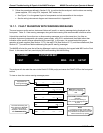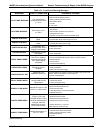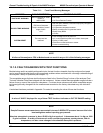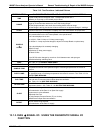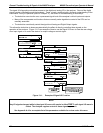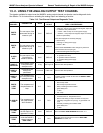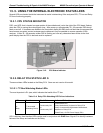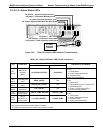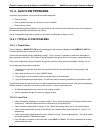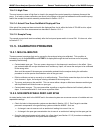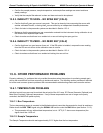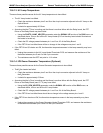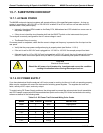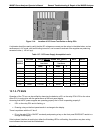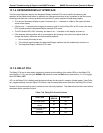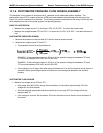
General Troubleshooting & Repair of the M400E Analyzer M400E Ozone Analyzer Operator’s Manual
13.4. GAS FLOW PROBLEMS
In general, flow problems can be divided into three categories:
Flow is too high
Flow is greater than zero, but is too low, and/or unstable
Flow is zero (no flow)
When troubleshooting flow problems, it is a good idea to first confirm that the actual flow and not the analyzer’s
flow detection hardware and software are in error.
Use an independent flow meter to perform a flow check as described in Section 12.3.5.
13.4.1. TYPICAL FLOW PROBLEMS
13.4.1.1. Flow is Zero
The unit displays a SAMPLE FLOW warning message on the front panel display or the SAMPLE FLOW Test
Function reports a zero or very low flow rate.
Confirm that the sample pump is operating (turning). If not, use an AC Voltmeter to make sure that power is
being supplied to the pump. If AC power is being supplied to the pump, but it is not turning, replace the pump.
If the pump is operating but the unit reports no gas flow, perform a flow check as described in Section 12.3.5.
If no indepen
dent flow meter is available:
1. Disconnect the gas lines from both the sample inlet and the exhaust outlet on the rear panel of the
instrument.
2. Make sure that the unit is in basic SAMPLE Mode.
3. Place a finger over an exhaust outlet on the rear panel of the instrument.
4. If gas is flowing through the analyzer, you will feel pulses of air being expelled from the exhaust outlet.
If gas flows through the instrument when it is disconnected from its sources of zero air, span gas or sample gas,
the flow problem is most likely not internal to the analyzer. Check to make sure that:
All calibrators/generators are turned on and working correctly.
Valves, regulators and gas lines are not clogged or dirty.
13.4.1.2. Low Flow
Check if the pump diaphragm is in good condition. If not, rebuild the pump (all Teledyne Instruments for
instructions). Check the spare parts list for information of pump rebuild kits.
Check for leaks as described in Section 12.3.4. Repair the leaking fitting, line or valve and re-check.
Check for the sample filter and the orifice filter for dirt. Replace filters (see Sections12.3.1 and 13.10.1
r
espectively).
Check for partially plugged pneumatic lines, orifices or valves. Clean or replace them. The critical orifice
should be replaced if it becomes plugged.
If an IZS option is installed in the instrument, press
CALZ and CALS. If the flow increases then suspect
a bad sample/cal valve.
242 04315 Rev. C1



